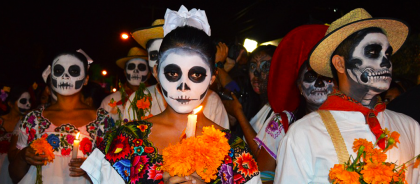The cult’s followers claim that Sacred Death performs miracles. At times, she is worshipped more than Jesus because, after all, he was taken by death, which means that death is stronger.
It’s believed that she helps in those cases when other saints are powerless. People often refuse help from the Catholic Church, alluding to the fact that it just preaches and doesn’t help. But Sacred Death does not make exceptions for anyone because everyone is equal before her—a prostitute, a policeman, a seller of pirated CDs, a politician, and even a drug dealer.
The local people say the following: “She simply helps and does not stick her nose into your sins. She does not require you to wait many years for a miracle, but simply fulfills your request. Whatever your wish it will be on your conscience. You alone are responsible for it.”
“It doesn’t matter what you give her: flowers, an apple, a joint of marijuana, candles, or something else. The only thing that matters is that the gift comes from your heart. It doesn’t matter if you’re a crime boss or a victim of a crime, gay or straight, rich or poor, sick or healthy, or smart or stupid. Santísima doesn’t have any prejudices, and she never places the blame on anyone. She is ready to provide free help.”
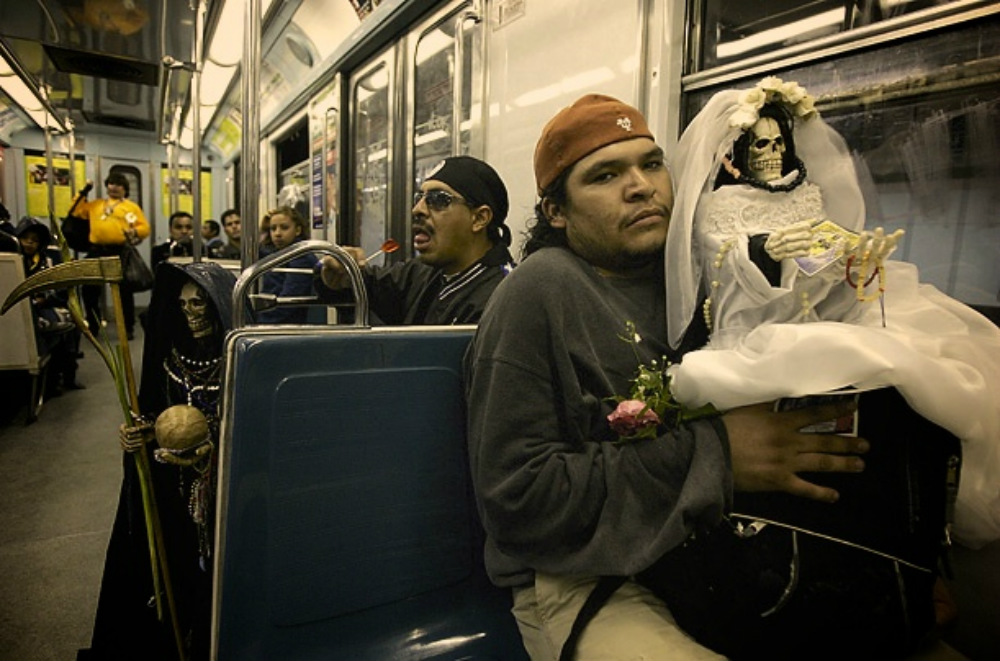
The cult’s followers claim that Sacred Death performs miracles. At times, she is worshipped more than Jesus because, after all, he was taken by death, which means that death is stronger.
It’s believed that she helps in those cases when other saints are powerless. People often refuse help from the Catholic Church, alluding to the fact that it just preaches and doesn’t help. But Sacred Death does not make exceptions for anyone because everyone is equal before her—a prostitute, a policeman, a seller of pirated CDs, a politician, and even a drug dealer.
The local people say the following: “She simply helps and does not stick her nose into your sins. She does not require you to wait many years for a miracle, but simply fulfills your request. Whatever your wish it will be on your conscience. You alone are responsible for it.”
“It doesn’t matter what you give her: flowers, an apple, a joint of marijuana, candles, or something else. The only thing that matters is that the gift comes from your heart. It doesn’t matter if you’re a crime boss or a victim of a crime, gay or straight, rich or poor, sick or healthy, or smart or stupid. Santísima doesn’t have any prejudices, and she never places the blame on anyone. She is ready to provide free help.”
In her outward appearance, the new Mexican saint resembles the well-known image of death—wearing a long robe with a hood and carrying a scythe. In one hand, she holds scales. In the other hand, she holds a globe, which means that all people on the planet are under her power. The globe also represents justice and equal rights for everyone, no matter what their origin and status are. Sometimes, Santísima appears in a white dress and with attributes of the Virgin Mary—the embodiment of purity and innocence. This was the origin of yet another of her names—the White Girl (Niña Blanca).
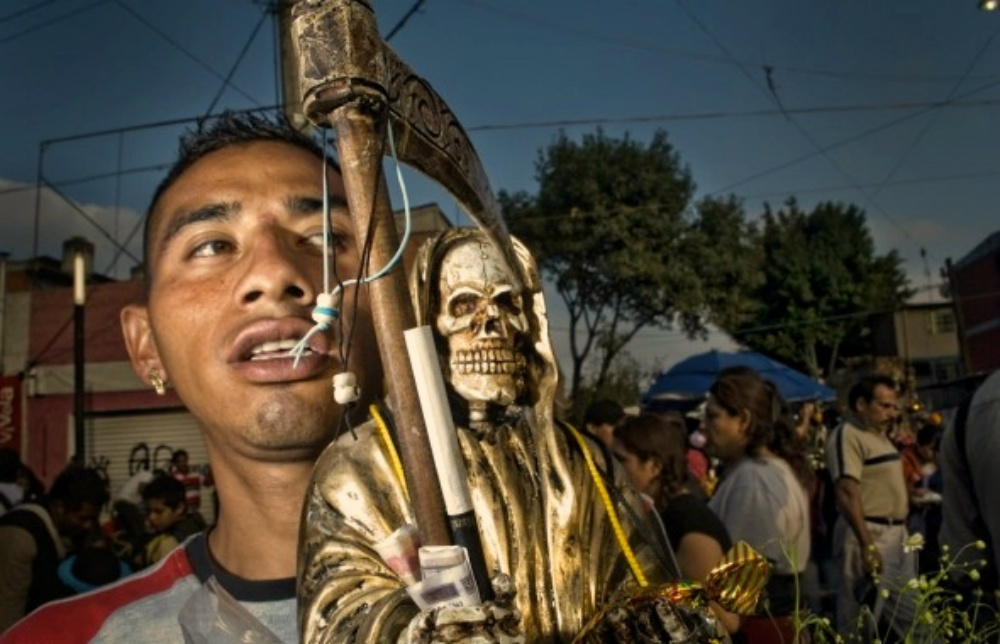
According to legend, people never used to know death, but, having grown weary from the burdens of eternal life, turned to God with the request to send them deliverance. God appeared to a young beautiful girl he had chosen and said that from now on she would become Death, an incorporeal spirit owning the final say on human life and putting an end to the sufferings of the earthly path. At the very same moment, her body broke apart, her beautiful young face turned into a bare skull, and, having received a scythe from the hand of God, Death set off on her route around the earth…
Special shrines are set up for Santa Muerte with an altar and the main statue of the deity (a female skeleton dressed in a sumptuous elegant dress). The image of Sacred Death can also be represented in the form of a colored figure or a painting. The details of the shrine depend on the problems that the believer hopes to solve. Santísima’s vestments may be practically any color and each color has its own meaning:
- white – the traditional attire and symbolizes chaste purity
- red – for help with love affairs
- green – to resolve problems with the law
- gold (the symbol of prosperity) or yellow – to overcome financial difficulties
- black (death) – the force overcoming life’s obstacles
- dark blue or purple – to awaken one’s mystical powers and connect to the world of spirits
- rainbow – to solve all your problems at once (the saint is quite often seen in rainbow attire).
Many small figurines of Santa Muerte are sold at markets for use in home altars. At nearly every merchant’s market stall you can see a little statue of Santa Muerte with dollars glued to it, or the statue may be in a drawer covered with coins.
There are also plenty of images of Santa Muerte with long dark blond or black hair. In criminal circles, statues of the deity are at times constructed from the real skeletons of deceased enemies.
A multitude of fresh flowers is placed on her altar: red and white roses, marigolds, carnations, tuberose, and tulips. Wilted flowers are immediately replaced.
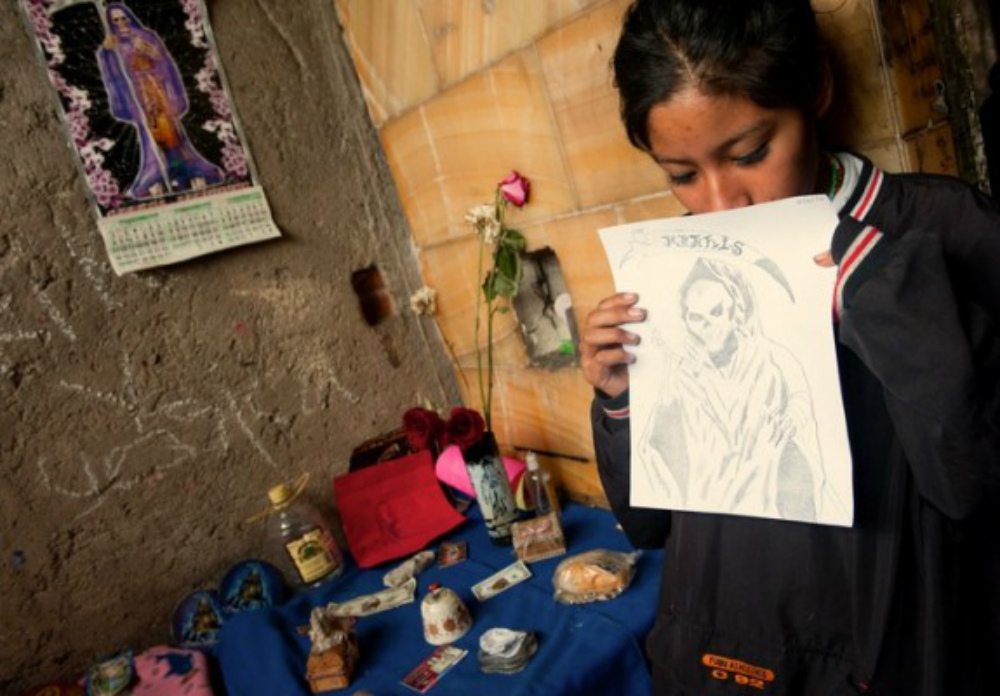
Fruit is also among the traditional offerings made to her, and of course, it must be fresh. Red and yellow apples (the symbol of well-being) are especially in favor. Santísima will not turn down coconuts, pineapples, mangoes, watermelons, or bananas either.
They often bring sweets as an offering to her—chocolate, honey, soft and hard candies, even Coca-Cola and chewing gum—so that life will be sweet and without bitterness. Alcoholic beverages are also among the offerings: tequila, rum, anisette, cognac, wine, liqueurs, and sometimes beer (the drinks must be in glass containers only).
The White Girl also loves cigars and cigarettes. People will bring her an offering of cigars or cigarettes in order to stop other people from envying them. As a rule, two items of tobacco products must be placed down (the number 2 and other even numbers are revered in this religion).
Clear water (must be in a glass container) is the main way to communicate with Sacred Death.
Bread is changed twice a week. Moreover, stale bread is not thrown out but placed under a tree in a park.
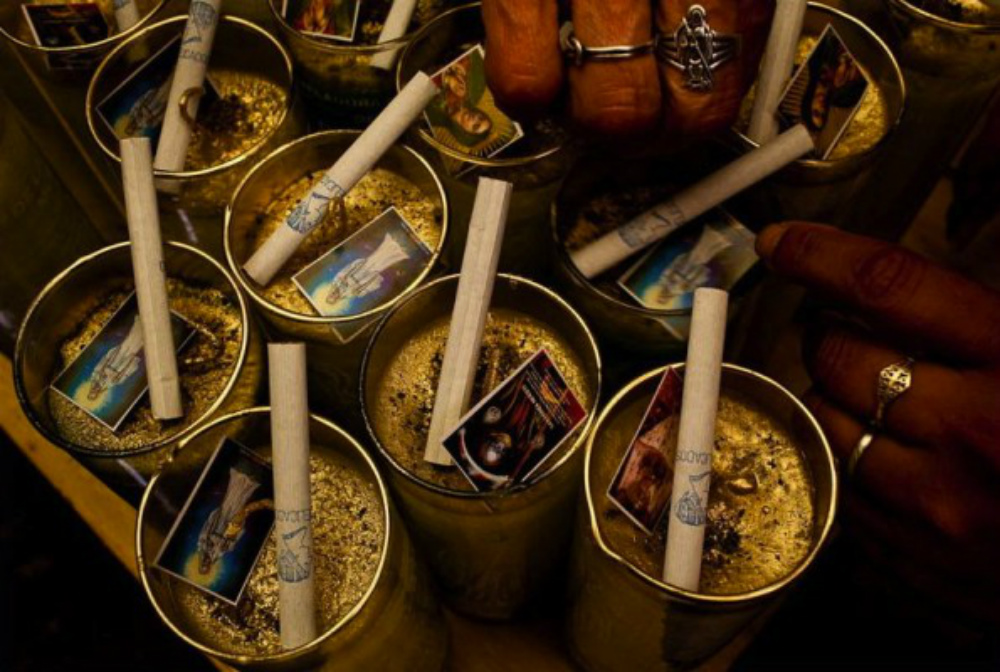
The last item is incense: frankincense, sandalwood, myrrh, rosemary, or musk. They help cleanse you from negative energy and bring luck.
Candles and essential oils won’t be out of place on the “Bony Lady’s” altar either. In addition to the items already mentioned, money and even cartridge shells are placed at her feet (for protection against a violent death).
There are rumors that Sacred Death is as jealous as she is strong. If you stop showing her signs of reverence and attention, then she may suddenly take you into her hands.
Santísima’s jealousy is also demonstrated by the fact that she does not tolerate images of other saints or spirits near her. The only saint who is allowed to be placed beside her is Saint Jude (not Iscariot), the protector of destitute people and the patron saint of dangerous undertakings. Believers are apprehensive about placing other saints near her gaze.

Santísima’s worshippers carry her image with them as a sign that they always remember her. This is usually a gold or silver pendant with a holy picture of Santa Muerte or in the form of a charm on a key chain. The amulet is tempered over the flame of a candle for greater effectiveness. You should not let other people touch the pendant. Many followers also get a tattoo depicting the saint on their body—this protects a person from bullets, arrest, and other unpleasantness.
Some rituals are only performed by children (as a rule, little girls) because Sacred Death is especially benevolent to their purity and innocence.
For the followers of Santa Muerte (unlike the Christian religion), it is customary to communicate as equals—you should straighten your shoulders and proudly hold your head high. While praying to the saint, you should look her straight in the eyes. Often, cigars are smoked towards the image of the saint’s face or statue of the saint for a particular form of cleansing. When you treat her to various offerings, you should also treat yourself.
For Santa Muerte to fulfill your wish, you should crawl towards her altar on your knees. This action is clearly shown in one of the episodes of the Breaking Bad series.
On the first night of every month, a mass is held and everyone who comes receives a blessing.
But some followers have found a cunning way to abandon the faith if necessary: you need to bathe in holy water three times and then leave the statue with a scythe in a Catholic church.
The Church condemns the cult, insisting that there is no connection between Santa Muerte and Christianity, but since there is religious freedom in Mexico, followers of Santa Muerte are not officially persecuted. Nevertheless, repression is periodically carried out against followers of this faith, in particular, the destruction of chapels devoted to Santa Muerte.
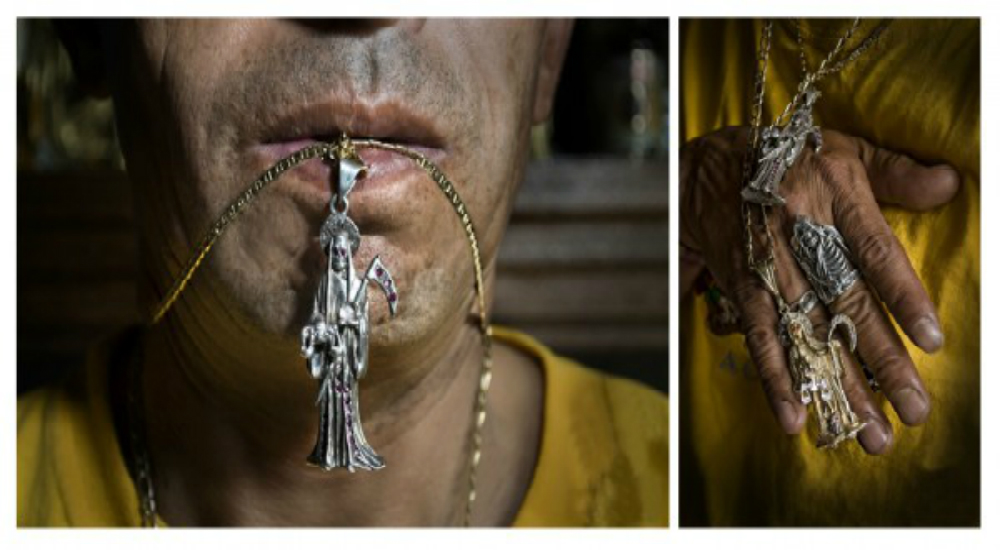
At the same time, the followers of this religion insist that their cult has nothing to do with black magic and still consider themselves to be faithful Catholics. Moreover, political parties sympathizing with this religion began to appear recently, and parishioners periodically organize protests and refuse to vote in elections for deputies who are opposed to the recognition of Santa Muerte.
Because of the fact that the cult of Sacred Death does not preach humility, forgiveness, patience (unlike Christianity), or other virtues that make people passive and easily controlled by the clergy, but, on the contrary, gives its followers confidence and strength to defend their rights, the Mexican government has an ambiguous relationship with the cult. On the one hand, they don’t approve of it, contemptuously calling it the “superstition of the dregs of society,” which a cultured and educated person should be ashamed of believing in. On the other hand, the cult exists and develops with the tacit support of the authorities, as the government and state officials themselves often turn to the “Madonna with the scythe” for help.
An amusing fact is that during the FIFA World Cup, Santísima is dressed in the colors of the Mexican flag (green, white, and red), and a soccer ball is placed in her hands instead of the traditional globe. All this is done so that the White Girl can bring good luck to the national team. Whether it helps or not, you can judge for yourself. But the fact remains that the Mexican team is the most feared opponent of the strongest team in the world, Brazil. Over the past ten years, Mexico has won six out of seven of the official matches played between these two countries.
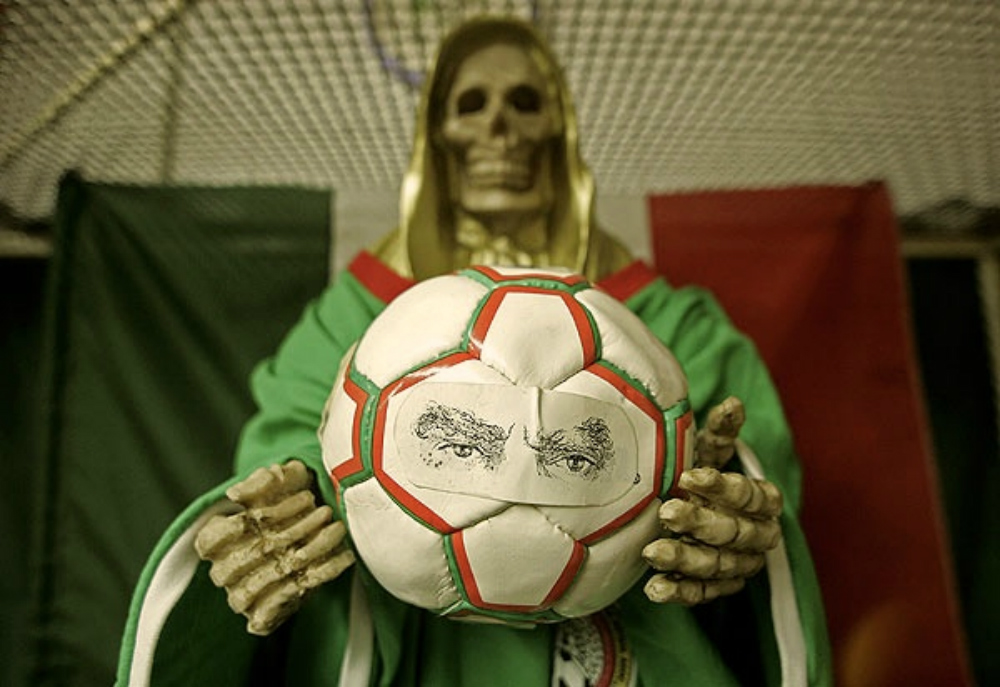
But it’s not only soccer that brings Santa Muerte into almost every home. Today, the image of Sacred Death is popular both in Mexico and far beyond its borders. This image has become a part of art, and artists and designers around the world actively use it in their works. A skeleton in an elegant dress appears on the canvases of Diego Rivera and Frida Kahlo and can be seen in the engravings and book illustrations by José Guadalupe Posada.
More recently, Nike has released a series of running shoes called Santa Muerte.
Moreover, if we look carefully at the photo of Rick Genest (Zombie Boy), the tattooed star of world runways, it’s not difficult to understand what the source of inspiration was for his “afterlife” image.
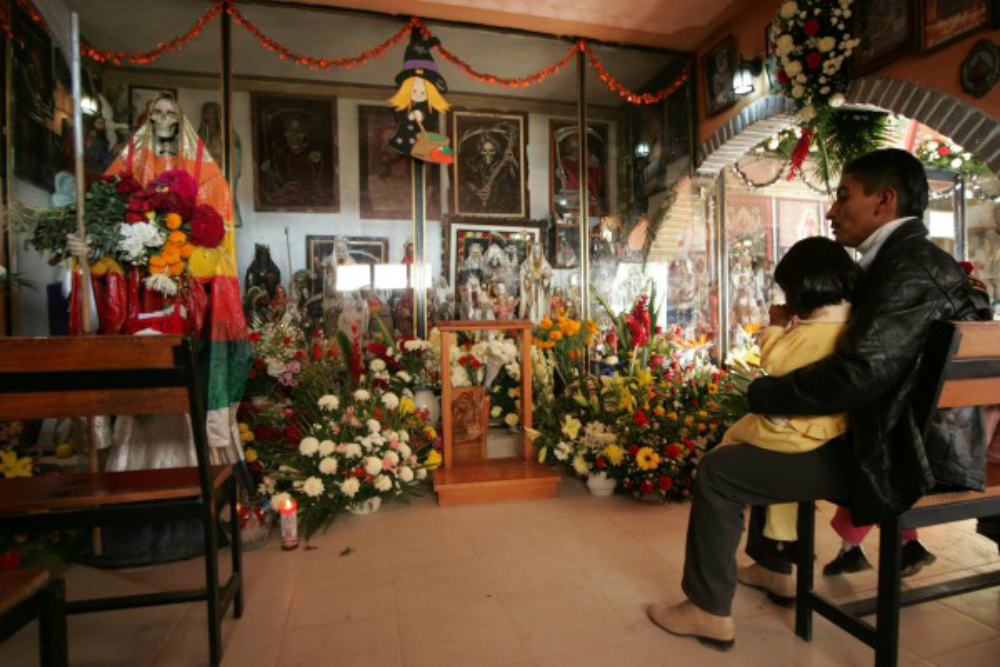
Mexico is a unique country where the relationship with death is radically different from the traditions we have known since childhood. The Day of the Dead (Día de Muertos) is an integral part of life for the majority of Mexicans, an annual celebration dedicated to the memory of the dead, which takes place on November 1st and 2nd. There’s a popular belief that, during these days, the souls of departed relatives visit peoples’ homes. The carnival is organized all over the country, sweets are prepared in the form of sugar skulls, and tequila flows like a river. Cemeteries are decorated with ribbons and flowers, and candles are lit along the roads to homes so that dead loved ones can find their way home.
The main attribute of the Day of the Dead is the figure of La Calavera Catrina, a female skeleton in a luxurious dress, a fashionista from the other world and a prototype of Sacred Death. The sheer variety of such figurines is amazing—in addition to chic outfits, Catrina can come with a trousseau in the form of a dressing table, a grand piano, a car, or even a jacuzzi. All too often, she appears as the most unexpected of characters: from a bride to a flamenco dancer, a rock star to a geisha, and anything in between.
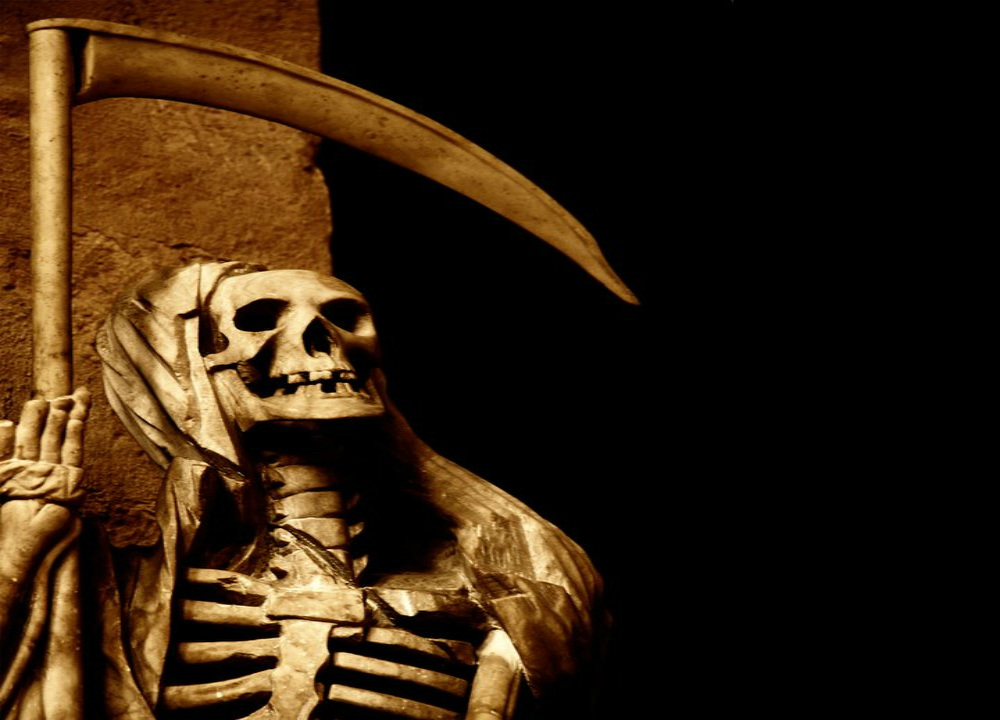
Día de Muertos is a highly colorful event with no place for grief. People dress up as vampires, werewolves, and Death itself. It’s also customary to sprinkle ashes over your head and wash the bones of your deceased relatives all night long. Songs, dances, and games of chance definitely accompany the celebration, and grieving and crying are strictly prohibited. Another of the Day of the Dead’s interesting traditions is the creation of caricatures of important people who are alive today accompanied by poetical obituaries.
The Day of the Dead is a day to celebrate life! It’s not in vain that Mexican folk wisdom says “I owe all the best in me to death!”

